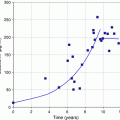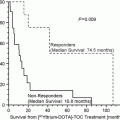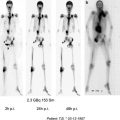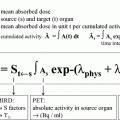Fig. 1
Images of a patient with a follicular lymphoma relapse. a FDG-PET recorded before RIT showed an abnormal focus in the mediastinum. b FDG-PET demonstrated a metabolic complete response as early as 6 weeks after 2 perfusions of 15 mCi/m2 of 90Y-epratuzumab tetraxetan
This study demonstrated that fractionated RIT with 90Y-epratuzumab tetraxetan achieved high rates of durable complete responses with manageable hematological toxicity in previously treated NHL patients. While fractionation may have improved the penetration of subsequent doses, the favorable efficacy and safety observed here even at high doses could also reflect antibody internalization with improved 90Y residence time, the more stable DOTA radiolabeling method used, or the lack of neutralizing antibodies induced with this humanized antibody.
5 Perspectives of Fractionated RIT Perspectives of Fractionated RIT
Different developments are being considered using 90Y-anti-CD22 epratuzumab. An ongoing study sponsored by the GOELAMS French lymphoma group will assess fractionated 90Y-epratuzumab tetraxetan RIT as consolidation after chemoimmunotherapy induction using CHOP-rituximab in first-line treatment of patients with diffuse large B cell lymphoma. The rationale for this consolidation treatment is the favorable targeting of MRD. This approach appears to be of interest in NHL patients >60 years old who are not candidates for BMTation. Targeting of antigens other than CD20 appears particularly interesting in the context of consolidation therapy, with the possibility of targeting populations of lymphoma cells not expressing CD20 or having lost its expression as a result of treatment. Moreover, the potential higher tumor doses delivered by fractionated 90Y-epratuzumab tetraxetan could offer a higher tumor response of aggressive type of lymphoma, as compared to Zevalin.
Another important perspective is the clinical evaluation of dual-targeted antibody/radioantibody therapy (Sharkey et al. 2009a, b; Mattes et al. 2008). Combining an unconjugated anti-CD20 antibody therapy with a radioimmunoconjugate binding to a non-competing antigen might improve responses by allowing optimal uptake of each agent. Mattes et al. (2008) showed in animal model the benefit of targeting of a non-competing antigen for consolidation after RIT using 90Y-epratuzumab tetraxetan. Tumor response and survival rates were improved when a consolidation using anti-CD20 veltuzumab was delivered after anti-CD22 RIT. Moreover, Sharkey et al. (2009a, b) demonstrated that injection of cold MAb after the radioactivity dose provided higher efficacy than injection before RIT, and that the amount of pre-dose of cold MAb should be minimized.
6 Conclusions
The results of phase I/II studies, as described here and elsewhere are very promising, suggesting a higher efficacy of fractionated RIT using 90Y-epratuzumab tetraxetan, as compared to single-dose RIT in a non-myeloablative protocol. The next clinical studies should assess this approach in relevant clinical indications: first-line treatment of diffuse large B cell lymphoma using chemoimmunotherapy induction and RIT consolidation, or first-line treatment of FL using dual-targeted antibody/radioantibody therapy with anti-CD20 cold MAb and anti-CD22 RIT.
References
Beaumier PL, Venkatesan P, Vanderheyden JL et al (1991) 186-Re radioimmunotherapy of small cell lung carcinoma xenografts in nude mice. Cancer Res 51:676–681PubMed
Brown JM, Giacca AJ (1998) The unique physiology of solid tumors: opportunities (and problems) for cancer therapy. Cancer Res 58:1408–1416PubMed
Buchsbaum DJ, Khazaeli MB, Liu TP, Bright S (1995) Fractionated radioimmunotherapy of human colon carcinoma xenografts with I-131-labeled monoclonal antibody CC49. Cancer Res 55:5881–5887
DeNardo SJ, DeNardo GL, O’Grady LF et al (1987) Radioimmunotherapy of lymphoma with fractionated I-131 Lym-1: phase I/II study [abstract]. J Nucl Med 28:1077
Stay updated, free articles. Join our Telegram channel

Full access? Get Clinical Tree








